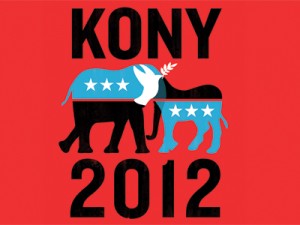Tonight the Kony 2012 campaign kicks into high gear with “Paint the Night.” This can serve as a moment to reflect on the power of narrative in social change, and the danger of the simplified story.
 A big focus of this blog is on the stories
that we tell about ourselves — the stories that trap, the stories that marginalize, and
the stories that liberate. Cultural organizing, in many ways, can be seen as a centering
of the narrative of social change. We can offer new narratives, show the flaws in
mainstream narratives, and uncover narratives that are kept out of the conversation. New
media has become a major way such narratives are constructed and negotiated, and
powerful strategies have been developed to center narrative in organizing efforts by
groups like SmartMeme.
A big focus of this blog is on the stories
that we tell about ourselves — the stories that trap, the stories that marginalize, and
the stories that liberate. Cultural organizing, in many ways, can be seen as a centering
of the narrative of social change. We can offer new narratives, show the flaws in
mainstream narratives, and uncover narratives that are kept out of the conversation. New
media has become a major way such narratives are constructed and negotiated, and
powerful strategies have been developed to center narrative in organizing efforts by
groups like SmartMeme.
The Kony campaign, in some ways, has been very adept at this kind of strategy. They have taken the meme of the campaign poster and flipped it, using it to make someone famous who currently does not want to be found. And with the creative use of documentary and social media, the reach has been incredible. The story Invisible Children is telling is one that has appealed to thousands of young people in the US. It more or less goes like this:
Once upon a time there was a very evil man, who forced children to do horrible things in war. He needs to be (individually) brought to justice, and you can be one of the heroes of this grassroots movement to save Ugandan children.
Despite its wide appeal, this story has drawn much valid criticism. The issue, from the narrative standpoint, is that while well-told and engaging, the story itself is flawed. There is truth in it — the crimes are very real and horrible, and putting Kony on trial in the international criminal court could be one part of a strategy to address the use of child soldiers in war. But there are a few issues:
- First of all, it is oversimplified, with a good-guy/bad-guy binary that leaves out some of the most important actors — particularly other Ugandans. All narratives need to be simplified to have meaning, but you can go too far.
- Second, It is totally devoid of context or systems, and thus doesn’t get to the root of the problem. Child soldiers have been used in 80 percent of civil wars in the last few decades, and the phenomenon results from a number of important factors such as type of government and amount of GDP invested in the military — not merely one psychopath.
- Third, It mimics too neatly the long-running colonial narrative of the western savior in Africa, which has certainly done more harm than good over the centuries. Meanwhile, the actual role that countries like the US have played in creating and perpetuating issues in Africa is silenced.
I don’t know what exactly the best narrative would be, as an outsider to the conflict. But I do know that it would need to be created by those who actually experienced the war. This debate reminds me of a number of questions we should ask ourselves as we develop the narratives that drive our organizing efforts:
- Does this narrative explain the real core problem being addressed?
- Does the solution it offers address that core problem?
- Does it include the most important actors?
- Are those most directly affected by the issue presented as active agents rather than just victims?
- Does it feel authentic to those experiencing the situation first hand?
- Does it draw on other, problematic or oppressive narratives in our culture?
There is power in the well-told, media-savvy narrative of social change, but without deep reflection, there are plenty of pitfalls along the way.


